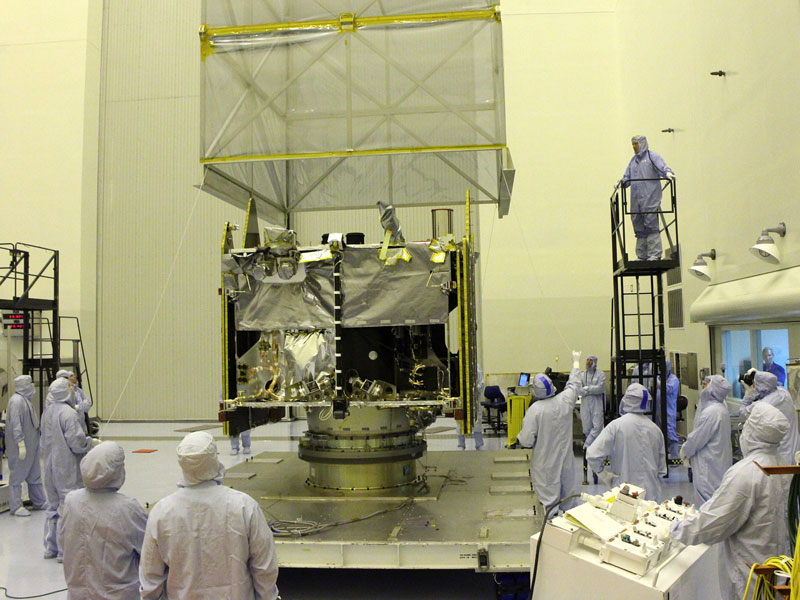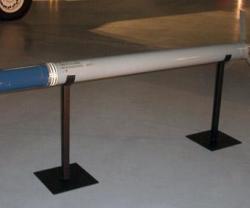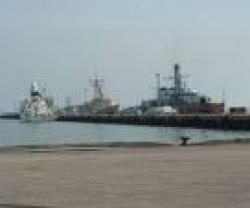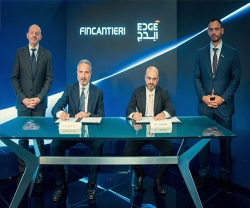Lockheed Martin Ships MAVEN Spacecraft to NASA
07.08.2013 North America
Lockheed Martin delivered NASA's Mars Atmosphere and Volatile EvolutioN (MAVEN) spacecraft to the Kennedy Space Center, Fla. on Friday, August 2.
The orbiter will now undergo three-and-a-half months of final processing in preparation for a November launch from Cape Canaveral Air Force Station aboard a United Launch Alliance Atlas V -401 rocket.
The MAVEN mission will be the first dedicated to surveying the upper atmosphere of Mars in an effort to understand the role that the loss of atmospheric gas to space played in changing the Martian climate. Lockheed Martin Space Systems near Denver designed and built the spacecraft and is responsible for testing, launch processing and mission operations.
“After completing a year of assembly and rigorous testing, we are thrilled that MAVEN has safely arrived at Kennedy Space Center and is ready to start the final months of processing,” said Guy Beutelschies, MAVEN Program Manager at Lockheed Martin Space Systems Company.
“Our successful delivery of the MAVEN spacecraft is a significant milestone, and many on our team have moved to Florida with MAVEN so they can continue working to prepare the orbiter to be ready when the Nov. 18 launch window opens,” he added.
The 1,784-pound spacecraft was shipped on a U.S. Air Force C-17 transport plane in an environmentally controlled container. The C-17, MAVEN and support personnel took off from Buckley Air Force Base in Aurora, Colo. and touched down at Kennedy Space Center's Shuttle Landing Facility, on one of the largest runways in the world. While at Kennedy, the spacecraft will undergo final processing including re-installation of the high-gain antenna, software testing, propellant loading, a spin balance, a second solar array deployment and illumination test, and a payload deployment test.
“It was great to see MAVEN leave Colorado and arrive at Florida. As thrilling as it was to fly with MAVEN on the C-17, I'm more looking forward to the day when it arrives at its final destination and we can begin our science observations,” said MAVEN Principal Investigator Bruce Jakosky from the University of Colorado Boulder's Laboratory for Atmospheric and Space Physics.
MAVEN's principal investigator is based at the University of Colorado at Boulder's Laboratory for Atmospheric and Space Physics. The University will provide science operations, science instruments and lead Education/Public Outreach. NASA's Goddard Space Flight Center manages the project and provides two of the science instruments for the mission. The University of California at Berkeley Space Sciences Laboratory provides science instruments for the mission. NASA's Jet Propulsion Laboratory, Pasadena, Calif., provides navigation support, the Deep Space Network and the Electra telecommunications relay hardware and operations.
The orbiter will now undergo three-and-a-half months of final processing in preparation for a November launch from Cape Canaveral Air Force Station aboard a United Launch Alliance Atlas V -401 rocket.
The MAVEN mission will be the first dedicated to surveying the upper atmosphere of Mars in an effort to understand the role that the loss of atmospheric gas to space played in changing the Martian climate. Lockheed Martin Space Systems near Denver designed and built the spacecraft and is responsible for testing, launch processing and mission operations.
“After completing a year of assembly and rigorous testing, we are thrilled that MAVEN has safely arrived at Kennedy Space Center and is ready to start the final months of processing,” said Guy Beutelschies, MAVEN Program Manager at Lockheed Martin Space Systems Company.
“Our successful delivery of the MAVEN spacecraft is a significant milestone, and many on our team have moved to Florida with MAVEN so they can continue working to prepare the orbiter to be ready when the Nov. 18 launch window opens,” he added.
The 1,784-pound spacecraft was shipped on a U.S. Air Force C-17 transport plane in an environmentally controlled container. The C-17, MAVEN and support personnel took off from Buckley Air Force Base in Aurora, Colo. and touched down at Kennedy Space Center's Shuttle Landing Facility, on one of the largest runways in the world. While at Kennedy, the spacecraft will undergo final processing including re-installation of the high-gain antenna, software testing, propellant loading, a spin balance, a second solar array deployment and illumination test, and a payload deployment test.
“It was great to see MAVEN leave Colorado and arrive at Florida. As thrilling as it was to fly with MAVEN on the C-17, I'm more looking forward to the day when it arrives at its final destination and we can begin our science observations,” said MAVEN Principal Investigator Bruce Jakosky from the University of Colorado Boulder's Laboratory for Atmospheric and Space Physics.
MAVEN's principal investigator is based at the University of Colorado at Boulder's Laboratory for Atmospheric and Space Physics. The University will provide science operations, science instruments and lead Education/Public Outreach. NASA's Goddard Space Flight Center manages the project and provides two of the science instruments for the mission. The University of California at Berkeley Space Sciences Laboratory provides science instruments for the mission. NASA's Jet Propulsion Laboratory, Pasadena, Calif., provides navigation support, the Deep Space Network and the Electra telecommunications relay hardware and operations.
Previous PostCAE Wins US Air Force Contract
Latest news
Latest events
EURONAVAL 2024
04 - 07 Nov 2024Paris Nord Villepinte - FranceINDODEFENCE 2024
06 - 09 Nov 2024Jakarta - IndonesiaBahrain International Airshow (BIAS) 2024
13 - 15 Nov 2024Sakhir Airbase, Sakhir - BahrainI/ITSEC 2024
02 - 06 Dec 2024Orlando, Florida - United States






















